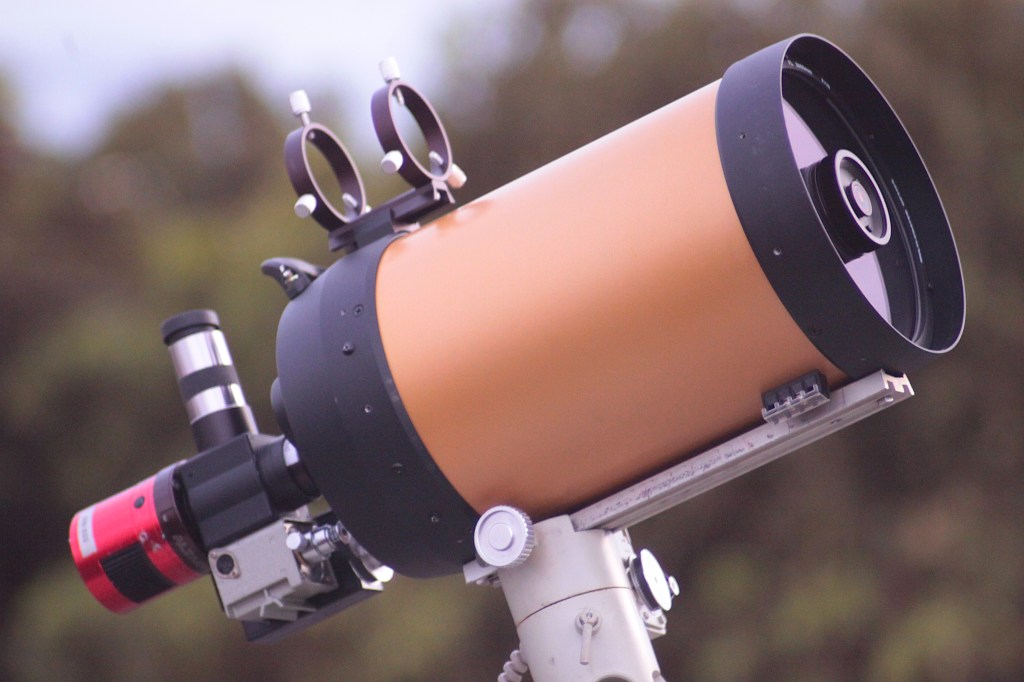This page features the different telescopes, cameras, and homebrewed equipment that I use to capture astronomical images.


Equipment | Telescopes, Cameras, & Accessories
Sky-Watcher Equinox 100 ED-APO
Meade LXD75 Mount OnStep Conversion
Vixen Super Polaris Mount
Modified Celestron Travel Scope 70
Binoculars | Pentax 10 by 50
Baader Neutral Density 5.0 Solar Filter
Telescope Travel Cases
Dovetail Clamp
DIY Astronomy Projects
DIY Go-to Telescope Controller for Vixen Great Polaris | OnStep
DIY Ultra-Portable Sky Tracker
DIY Peltier-Cooled and Filter-Modified DSLR
DIY Planetary Camera
DIY Guide Camera
DIY Field Battery
DIY Tamron to Astrocam Adapter
DIY Universal Camera Adapter
DIY Smartphone-to-Telescope Adapter
DIY Battery Adapter for DSLR | Canon 1100D
DIY Aluminum Plate for Telescopes
DIY Dew Heater
DIY Intervalometer for Deep-Sky Imaging
DIY Electronic Automatic Focuser
DIY Telescope Cleaning
DIY Flat Field Panel
DIY Off-Axis Guider (OAG)
DIY Focal Reducer
DIY Projector Lens Telescope
DIY Laser Pointer Finder
DIY Pier Extension
DIY Parallelogram Mount for Binoculars
DIY Binoviewers for Telescopes
DIY Low-Profile Focuser
DIY Polar Scope
Night Sky in Focus © Anthony Urbano | Bacoor, Philippines
Awesome. I should try my hands on these, too! :)
Very Interesting Bro, Amazing Work you have done specially in DIY section.
Sorry for asking very beginner questions but I am new in this field :)
I recently acquired Sky-watcher Dobsonian 10″ Manual telescope.It came with two eyepiece 10mm and 25mm, with 2x Barlow (I am not sure but all of them are 1.25″) .
Q1# What is the difference between 1.25 and 2″ eyepieces? Do they make any difference in seeing quality of planets?
Q2# I can see the Jupiter/moon quite well, but cannot view Saturn clearly, its very blur. I want to ask that which eyepiece I should have in general to get clear view of planets like Jupiter, SATURN (specially interested in this planet, what eyepiece will make it appear large/good) mars, and what should be used for DSO like any galaxies?
Q3# After having Live view, I like to take photographs, For beginning this astro-photography journey, which camera should be suitable for me ? As I saw few images at your site and they are amazingly CLEAR (surely they are register/stacked images) but they look amazing, how can I get them? Also can I use my smartphone in this regard?
Thanks Syed!
Eyepieces follow a certain standard in the size of the outside diameter of the barrel (the part that you insert into the focuser). Most eyepieces have 1.25 inch diameter, but others follow the 2 inch diameter standard. For most common eyepieces (not the ones built for special purposes), there should be no difference in the image quality. The quality of the image seen through an eyepiece depends primarily on the “lens” and not on the size of the barrel.
I suggest you simply use the same eyepiece (I suppose the 10 mm) you used for Jupiter. If you could see Jupiter clearly, then you should see Saturn clearly as well. Maybe you need to double check the telescope’s focus, and be extra careful when adjusting it. For galaxies, use the 25 mm eyepiece. Note that you may need to observe from a place with minimal city lights (light pollution) in order to see some galaxies.
Good luck!
Eteny
The Jupiter look clear with 10mm aided with 2x Barlow. But its too bright I can only see two belts and no GRS showed ever, whiteness is high. I tried every possible focusing , but couldn’t get much details.
Do I have to implement some FILTERS?
Try performing a simple test to check if your telescope is properly collimated (optics aligned properly):
1. Bring the planet into focus. Turn the focus adjustment knob so that the eyepiece along with the focuser’s barrel moves “inward” and look at the non-foucsed image of the planet. There should be a dark region somewhere in the middle caused by the secondary mirror. A properly collimated telescope should have this dark region perfectly centered.
2. Bring the planet again into focus. Now this time, turn the focus adjustment knob so that the eyepiece along with the focuser’s barrel moves “outward” and look at the non-foucsed image of the planet. Again, there should be a dark region somewhere in the middle, caused by the secondary mirror. This dark region perfectly centered as well.
No need for filters :)
Good luck!
If I add another 2x Barlow over previous 2x Barlow to view Jupiter, will it make image more clear? or does single 4x or 5x Barlow is more suitable then double 2x?
Try using one more Barlow to make the image larger (although it is best if you simply use one 4X Barlow than using two 2X Barlows stacked together).
I am trying to find a good telescope in the Philippines. Do you know where I can purchase one? Also, Very good site and a great service. Thanks!
Thank you very much sir.
I find your website very inspirational, most especially the “Can-do” spirit of making the equipment that you don’t have or can’t find. You have achieved amazing results and usually with improvised solutions and accessories.
I would be most interested in seeing more details of your equipment (mounts and platforms, telescopes, clock drive, cameras, etc). The slide show windows of the site offer tantalizing glimpses of the equipment, but, the cycle times are much too short to for me to pick up details before the next slide appears. My web browser doesn’t allow me to stop on the images for a better look. Would it be possible to slow the cycle time?
Thanks, I am uploading separate photos now on various pages. Feel free to explore this site. Thanks!